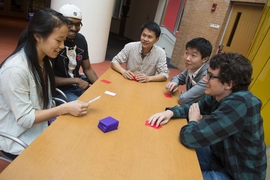MIT’s Teaching and Learning Laboratory (TLL) has created 47 STEM Concept Videos to help students connect the concepts they learn in introductory STEM courses to concrete, real-world problems. Students can watch the videos to prepare for class or review a concept for an exam. Instructors can use them to supplement classroom instruction, using snippets or the entire video, most of which are under 15 minutes. Throughout the videos, viewers are prompted to pause to actively engage with the material — to predict the result of demonstrations, engage in a discussion of concepts, or perform activities tied to the video’s intended learning outcomes.
Some examples of questions that the videos pose include:
- Why is the concept of divergence useful to researchers designing helmets to protect soldiers from the shockwaves of explosions?
- What is the connection between martial arts and torque?
- How can the concept of latent heat be used to design more energy-efficient buildings?
The videos utilize animations, visualizations, demonstrations, and examples from a variety of engineering and science disciplines. A video on “Vector Fields” contains footage of a smoke probe visualization of airflow over a model of an F16 aircraft shot in MIT’s Wright Brothers Wind Tunnel. Another video, entitled “Feedback Loops,” uses animations of blood-glucose regulation to highlight how feedback loops pass information in the body to maintain homeostasis or elicit a particular biological response.
The videos are freely available on the TLL website and through MIT OpenCourseWare (OCW) under Creative Commons licenses. The initial videos were posted to OCW in 2012, and the final videos were posted in August 2014. Since being posted the videos have received over 100,000 hits. Each video is accompanied by an instructor’s guide that describes how the video can be used and provides other resources to reinforce student learning.
Based on best practices in instructional and multimedia design, the videos grab the viewer’s attention by asking a provoking question or describing a real-world phenomenon. They tell viewers what prerequisite knowledge they will need to understand the topic and what they will learn by watching the video. (To find out more about the video-design process and the literature that guided it, please see the paper that TLL presented at the American Society of Engineering Education Annual Conference, which received the award for Best Paper in 2013.)
Many of the videos target concepts around which student misconceptions and misunderstandings exist. For example, John Lienhard, the Abdul Latif Jameel Professor of Water and Food, who narrated and provided technical content for two videos, “Entropy” and “Equilibrium vs. Steady State,” recognized that “both of these videos address difficult thermodynamic concepts. Developing these scripts required streamlining complex ideas without losing technical precision. The resulting videos are a concise overview of challenging material. They were also fun to do.”
To produce the STEM Concept Videos, TLL collaborated with MIT faculty, instructors, postdocs, and graduate students who wrote scripts and created the narration. MIT’s Academic Media Production Services (AMPS) and Free Energy Productions were responsible for shooting and post-production. The effort was funded by the MIT - Singapore University of Technology and Design (SUTD) Collaboration. According to Sanjay Sarma, former director of the SUTD-MIT Collaboration and now director of MIT’s Office of Digital Learning (ODL), “While the videos were originally conceived to supplement the curriculum that was being developed at SUTD, in fact, they support the cross-disciplinary, problem-solving approach that many engineering schools, including MIT, are now experimenting with.”






